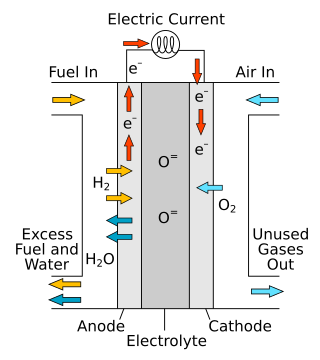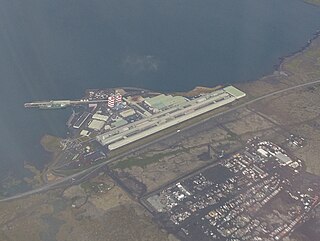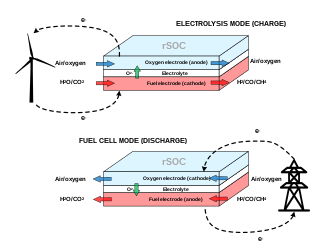Related Research Articles
Electrochemistry is the branch of physical chemistry concerned with the relationship between electrical potential difference, as a measurable and quantitative phenomenon, and identifiable chemical change, with the potential difference as an outcome of a particular chemical change, or vice versa. These reactions involve electrons moving via an electronically-conducting phase between electrodes separated by an ionically conducting and electronically insulating electrolyte.

In chemistry and manufacturing, electrolysis is a technique that uses direct electric current (DC) to drive an otherwise non-spontaneous chemical reaction. Electrolysis is commercially important as a stage in the separation of elements from naturally occurring sources such as ores using an electrolytic cell. The voltage that is needed for electrolysis to occur is called the decomposition potential. The word "lysis" means to separate or break, so in terms, electrolysis would mean "breakdown via electricity".
An electrolyte is a medium containing ions that is electrically conducting through the movement of those ions, but not conducting electrons. This includes most soluble salts, acids, and bases dissolved in a polar solvent, such as water. Upon dissolving, the substance separates into cations and anions, which disperse uniformly throughout the solvent. Solid-state electrolytes also exist. In medicine and sometimes in chemistry, the term electrolyte refers to the substance that is dissolved.

A sodium–sulfur battery is a type of molten-salt battery that uses liquid sodium and liquid sulfur electrodes. This type of battery has a similar energy density to lithium-ion batteries, and is fabricated from inexpensive and non-toxic materials. However, due to the high operating temperature required, as well as the highly corrosive and reactive nature of sodium and sodium polysulfides, these batteries are primarily suited for stationary energy storage applications, rather than for use in vehicles. Despite their low cost, molten sodium-sulfur batteries suffer from safety and durability issues, such as a short cycle life of fewer than 1000 cycles on average. As a result, these batteries have not achieved significant commercial deployment.

A solid oxide fuel cell is an electrochemical conversion device that produces electricity directly from oxidizing a fuel. Fuel cells are characterized by their electrolyte material; the SOFC has a solid oxide or ceramic electrolyte.

The alkaline fuel cell (AFC), also known as the Bacon fuel cell after its British inventor, Francis Thomas Bacon, is one of the most developed fuel cell technologies. Alkaline fuel cells consume hydrogen and pure oxygen, to produce potable water, heat, and electricity. They are among the most efficient fuel cells, having the potential to reach 70%.
A thermionic converter consists of a hot electrode which thermionically emits electrons over a potential energy barrier to a cooler electrode, producing a useful electric power output. Caesium vapor is used to optimize the electrode work functions and provide an ion supply to neutralize the electron space charge.
A magnetohydrodynamic generator is a magnetohydrodynamic converter that transforms thermal energy and kinetic energy directly into electricity. An MHD generator, like a conventional generator, relies on moving a conductor through a magnetic field to generate electric current. The MHD generator uses hot conductive ionized gas as the moving conductor. The mechanical dynamo, in contrast, uses the motion of mechanical devices to accomplish this.
An atomic battery, nuclear battery, radioisotope battery or radioisotope generator is a device which uses energy from the decay of a radioactive isotope to generate electricity. Like nuclear reactors, they generate electricity from nuclear energy, but differ in that they do not use a chain reaction. Although commonly called batteries, they are technically not electrochemical and cannot be charged or recharged. They are very costly, but have an extremely long life and high energy density, and so they are typically used as power sources for equipment that must operate unattended for long periods of time, such as spacecraft, pacemakers, underwater systems and automated scientific stations in remote parts of the world.

Electrolysis of water is using electricity to split water into oxygen and hydrogen gas by electrolysis. Hydrogen gas released in this way can be used as hydrogen fuel, or remixed with the oxygen to create oxyhydrogen gas, for use in welding and other applications.

Molten-salt batteries are a class of battery that uses molten salts as an electrolyte and offers both a high energy density and a high power density. Traditional non-rechargeable thermal batteries can be stored in their solid state at room temperature for long periods of time before being activated by heating. Rechargeable liquid-metal batteries are used for industrial power backup, special electric vehicles and for grid energy storage, to balance out intermittent renewable power sources such as solar panels and wind turbines.
Beta-alumina solid electrolyte (BASE) is a fast ion conductor material used as a membrane in several types of molten salt electrochemical cell. Currently there is no known substitute available. β-Alumina exhibits an unusual layered crystal structure which enables very fast ion transport. β-Alumina is not an isomorphic form of aluminium oxide (Al2O3), but a sodium polyaluminate. It is a hard polycrystalline ceramic, which, when prepared as an electrolyte, is complexed with a mobile ion, such as Na+, K+, Li+, Ag+, H+, Pb2+, Sr2+ or Ba2+ depending on the application. β-Alumina is a good conductor of its mobile ion yet allows no non-ionic (i.e., electronic) conductivity. The crystal structure of the β-alumina provides an essential rigid framework with channels along which the ionic species of the solid can migrate. Ion transport involves hopping from site to site along these channels. Since the 1970's this technology has been thoroughly developed, resulting in interesting applications. Its special characteristics on ion and electrical conductivity make this material extremely interesting in the field of energy storage.

The ZEBRA battery is a type of rechargeable molten salt battery based on commonly available materials – primarily nickel metal and the sodium and chloride from conventional table salt. It is technically known as the sodium–nickel–chloride battery, and sometimes as a sodium–metal–halide battery. The common name comes from its development under the Zeolite Battery Research Africa Project, started in South Africa in 1985.

Aluminium smelting is the process of extracting aluminium from its oxide, alumina, generally by the Hall-Héroult process. Alumina is extracted from the ore bauxite by means of the Bayer process at an alumina refinery.
The Glossary of fuel cell terms lists the definitions of many terms used within the fuel cell industry. The terms in this fuel cell glossary may be used by fuel cell industry associations, in education material and fuel cell codes and standards to name but a few.

A solid oxide electrolyzer cell (SOEC) is a solid oxide fuel cell that runs in regenerative mode to achieve the electrolysis of water by using a solid oxide, or ceramic, electrolyte to produce hydrogen gas and oxygen. The production of pure hydrogen is compelling because it is a clean fuel that can be stored, making it a potential alternative to batteries, methane, and other energy sources. Electrolysis is currently the most promising method of hydrogen production from water due to high efficiency of conversion and relatively low required energy input when compared to thermochemical and photocatalytic methods.

Solid-state ionics is the study of ionic-electronic mixed conductor and fully ionic conductors and their uses. Some materials that fall into this category include inorganic crystalline and polycrystalline solids, ceramics, glasses, polymers, and composites. Solid-state ionic devices, such as solid oxide fuel cells, can be much more reliable and long-lasting, especially under harsh conditions, than comparable devices with fluid electrolytes.
A Johnson thermoelectric energy converter or JTEC is a type of solid-state heat engine that uses the electrochemical oxidation and reduction of hydrogen in a two-cell, thermal cycle that approximates the Ericsson cycle. It is under investigation as a viable alternative to conventional thermoelectric conversion. Lonnie Johnson invented it and claims the converter exhibits an energy conversion efficiency of as much as 60%, however, this claim is at a theoretical level based on comparison with a Carnot cycle and assumes a temperature gradient of 600 °C. It was originally proposed for funding to the Office of Naval Research but was refused. Johnson obtained later funding by framing the engine as a hydrogen fuel cell. Johnson had been collaborating with PARC on development of the engine.

In electrochemistry, a thermogalvanic cell is a kind of galvanic cell in which heat is employed to provide electrical power directly. These cells are electrochemical cells in which the two electrodes are deliberately maintained at different temperatures. This temperature difference generates a potential difference between the electrodes. The electrodes can be of identical composition and the electrolyte solution homogeneous. This is usually the case in these cells. This is in contrast to galvanic cells in which electrodes and/or solutions of different composition provide the electromotive potential. As long as there is a difference in temperature between the electrodes a current will flow through the circuit. A thermogalvanic cell can be seen as analogous to a concentration cell but instead of running on differences in the concentration/pressure of the reactants they make use of differences in the "concentrations" of thermal energy. The principal application of thermogalvanic cells is the production of electricity from low-temperature heat sources. Their energetic efficiency is low, in the range of 0.1% to 1% for conversion of heat into electricity.

A reversible solid oxide cell (rSOC) is a solid-state electrochemical device that is operated alternatively as a solid oxide fuel cell (SOFC) and a solid oxide electrolysis cell (SOEC). Similarly to SOFCs, rSOCs are made of a dense electrolyte sandwiched between two porous electrodes. Their operating temperature ranges from 600°C to 900°C, hence they benefit from enhanced kinetics of the reactions and increased efficiency with respect to low-temperature electrochemical technologies.
References
- ↑ N. Weber, "A Thermoelectric Device Based on Beta-Alumina Solid Electrolyte", Energy Conversion 14, 1–8 (1974).
- 1 2 T. K. Hunt, N. Weber, T. Cole, "High Efficiency Thermoelectric Conversion with Beta″-Alumina Electrolytes, The Sodium Heat Engine", Solid State Ionics 5, 263–266 (1981).
- ↑ "Thermoelectricity - Alkali Metal Thermal Electric Generators AMTEC". www.mpoweruk.com. Retrieved 2021-01-20.
- ↑ R. Williams, B. Jeffries-Nakamura, M. Underwood, B. Wheeler, M. Loveland, S. Kikkert, J. Lamb, T. Cole, J. Kummer, C. Bankston, J. Electrochem. Soc., V. 136, p. 893–894 (1989).
- ↑ R. M. Williams, B. Jeffries Nakamura, M. L. Underwood, M. A. Ryan, D. O'Connor, S. Kikkert (1992) "High Temperature Conductivity of Potassium Beta″ Alumina", Solid State Ionics, V. 53–56, p. 806–810.
- ↑ R. M. Williams, A. Kisor, M. A. Ryan (1995) "Time Dependence of the High Temperature Conductivity of Sodium and Potassium Beta″ Alumina in Alkali Metal Vapor", J. Electrochem. Soc., V. 142, p. 4246.
- ↑ R. M. Williams, A. Kisor, M. A. Ryan, B. Jeffries Nakamura, S. Kikkert, D. O'Connor (1995) "Potassium Beta″ Alumina/Potassium/Molybdenum Electrochemical Cells", 29th Intersociety Energy Conversion Engineering Conference Proceedings, AIAA, Part 2, p. 888.
- ↑ A. Barkan, T. Hunt, B. Thomas, (1999) "Potassium AMTEC Cell Performance", SAE Technical Paper 1999-01-2702, Barkan, A. (1999). "Potassium AMTEC Cell Performance". SAE Technical Paper Series. Vol. 1. doi:10.4271/1999-01-2702..
- ↑ R. M. Williams, M. E. Loveland, B. Jeffries-Nakamura, M. L. Underwood, C. P. Bankston, H. Leduc, J. T. Kummer (1990) "Kinetics and Transport at AMTEC Electrodes, I", J. Electrochem. Soc. V. 137, p. 1709.
- ↑ R. M. Williams, B. Jeffries-Nakamura, M. L. Underwood, C. P. Bankston, J. T. Kummer (1990) "Kinetics and Transport at AMTEC Electrodes II", J. Electrochem. Soc. 137, 1716.
- ↑ R. M. Williams, M. A. Ryan, C. Saipetch, H. LeDuc (1997) "A Quantitative Tunneling/Desorption Model for the Exchange Current at the Porous Electrode/Beta-Alumina/Alkali Metal Gas Three-Phase Zone at 700-1300", p. 178 in "Solid-State Chemistry of Inorganic Materials", edited by Peter K. Davies, Allan J. Jacobson, Charles C. Torardi, Terrell A. Vanderah, Mater. Res. Soc. Symp. Proc. Volume 453, Pittsburgh, PA.
- ↑ R. M. Williams, M. A. Ryan, H. LeDuc, R. H. Cortez, C. Saipetch, V. Shields, K. Manatt, M. L. Homer (1998) "A Quantitative Model for the Exchange Current of Porous Molybdenum Electrodes on Sodium Beta-Alumina in Sodium Vapor", paper 98-1021, Intersociety Energy Conversion Engineering Proceedings, Colorado Springs, Colorado, (1998).
- ↑ C. B. Vining, R. M. Williams, M. L. Underwood, M. A. Ryan, J. W. Suitor (1993) "Reversible Thermodynamic Cycle for AMTEC Power Conversion", J. Electrochem. Soc. V. 140, p. 2760.
- ↑ Lonnie G. Johnson (2019). "Johnson Thermo-Electrochemical Converter (JTEC) as a Heat to Electric Generator for Nuclear Power Systems," Nuclear and Emerging Technologies for Space, American Nuclear Society Topical Meeting, Richland, WA, February 25-28, 2019. Retrieved 22 Oct. 2021.
- 1 2 Jack F. Mondt and Robert K. Sievers (2014). "[https://trs.jpl.nasa.gov/bitstream/handle/2014/19252/98-0546.pdf?sequence=1 Alkali Metal Thermal to Electric Converter (AMTEC) Technology Development for Potential Deep Space Scientific Missions," NASA Jet Propulsion Laboratory. Retrieved 22 October 2021.
- ↑ M.A. Ryan (1999). "The alkali metal thermal-to-electric converter for Solar System exploration", 18th Int. Conference on Thermoelectrics, ICT'99, 29 Aug.-2 Sept. 1999. DOI: 10.1109/ICT.1999.843468